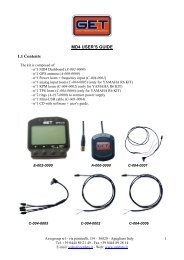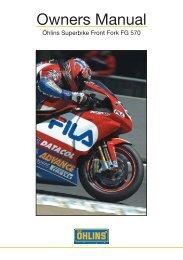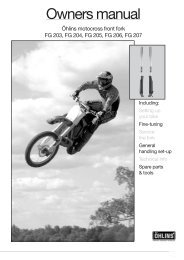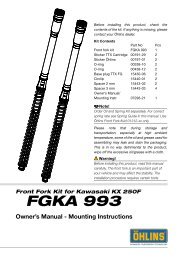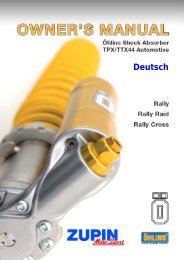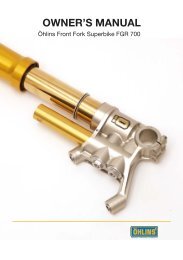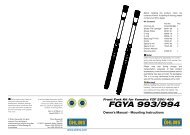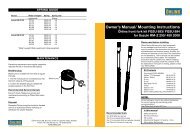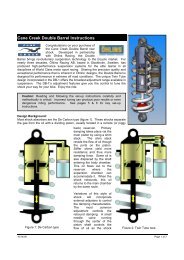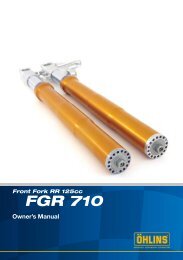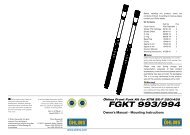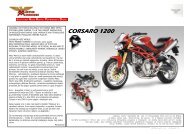Owners Manual - Zupin
Owners Manual - Zupin
Owners Manual - Zupin
Create successful ePaper yourself
Turn your PDF publications into a flip-book with our unique Google optimized e-Paper software.
<strong>Owners</strong> <strong>Manual</strong><br />
Öhlins Superbike Front Fork FG 670
Safety signals<br />
Important information concerning safety is<br />
distinguished in this manual by the<br />
following notations:<br />
!<br />
This Safety alert symbol means: Caution!<br />
Your safety is involved.<br />
2<br />
! WARNING!<br />
Failure to follow warning instructions could<br />
result in severe or fatal injury to anyone<br />
working with, inspecting or using the suspension,<br />
or to bystanders.<br />
CAUTION!<br />
Caution indicates that special precautions<br />
must be taken to avoid damage to the<br />
suspension.<br />
NOTE!<br />
This indicates information that is of importance<br />
with regard to procedures.<br />
Introduction<br />
All of Öhlins advanced suspension products<br />
are adapted to the brand and model. This<br />
means that length, travel spring action and<br />
damping charac teristics, are tested individually<br />
just for the motorcycle that you have<br />
decided to fit with Öhlins suspension.<br />
Before installation<br />
Öhlins Racing AB can not be held re spon -<br />
si ble for any damage whatsoever to suspen<br />
sion or vehicle, or injury to persons, if<br />
the instruc tions for fitting and main tenance<br />
are not fol lowed exactly. Similarly, the<br />
warranty will be come null and void if the<br />
instructions are not ad hered to.<br />
© Öhlins Racing AB.<br />
All rights reserved.<br />
Any reprinting or unauthorized use<br />
without the written permission of<br />
Öhlins Racing AB is prohibited.<br />
Printed in Sweden.<br />
! WARNING!<br />
1. Installing a suspension, that is not approved<br />
by the vehicle man u fac tur er, may<br />
affect the stability of your ve hi cle. Öhlins<br />
Rac ing AB cannot be held responsible for<br />
any per son al in ju ry or dam age what so ev er<br />
that may oc cur after fi t ting the sus pen sion.<br />
Contact an Öhlins deal er for advice.<br />
2. Please study and make certain that you<br />
ful ly un der stand all the mount ing in struc tions<br />
and the owner´s man u als before han dling<br />
this suspension kit. If you have any questions<br />
regarding proper in stal la tion pro ce dures,<br />
contact an Öhlins deal er or.<br />
3. The vehicle service manual must be<br />
re ferred to when installing the Öhlins suspension.<br />
NOTE!<br />
Öhlins products are subject to con tin u al<br />
improve ment and de vel op ment. Con se -<br />
quent ly, although these in struc tions in clude<br />
the most up-to-date in for ma tion available<br />
at the time of print ing, there may be minor<br />
dif fer enc es between your sus pen sion and<br />
this manual. Please con sult your Öhlins<br />
dealer if you have any ques tions with regard<br />
to the con tents of the manual.<br />
NOTE!<br />
During storage and transportation, es pe -<br />
cial ly at high ambient tem per a ture, the oil<br />
and grease used for as sem bling may run<br />
out inside the pack ing and dam age the expanded<br />
pol y sty rene pack ing ma te ri al. This<br />
is not unusual and is in no way det ri men tal<br />
to the suspension.
Öhlins Front Fork FG 670<br />
This Super Bike front fork is an improved<br />
version of FG 570 with pressurised damping<br />
system. FG 670 is based on 6 years<br />
experience from factory road racing. The<br />
pressurised damping system improves the<br />
front fork function at high frequency movements.<br />
The immediate damping responses<br />
improve the tyre feeling and also give more<br />
possibilities for adjustments. Of course<br />
the combination of spring and air-gap (oil<br />
level*) still gives a possibility to adjust the<br />
characteristic of the fork to suit different<br />
tracks and riders.<br />
For example a soft spring in combination<br />
with a small air-gap (high oil level) gives a<br />
more progressive action of the front forks.<br />
NOTE!<br />
Gas pressure should not be changed or<br />
used as an alternative to adjust the damping.<br />
For better understanding, please refer to<br />
our oil level chart see page 17.<br />
A telescopic front fork is depending on a<br />
smooth friction-free action. Make sure your<br />
front forks are serviced regularly and don’t<br />
use strong solvents such as brake cleaner<br />
to clean the front forks. This will dry out the<br />
seals and cause friction.<br />
Contents<br />
Before installation...........................................................2<br />
Öhlins front fork FG 670.................................................3<br />
Adjusters ...........................................................................4<br />
Setting up your forks......................................................5<br />
Changing springs ...........................................................6<br />
Changing seals...............................................................7<br />
Dismantling the forks .....................................................8<br />
Assembly of the forks ..................................................12<br />
Oil level adjustment......................................................17<br />
Troubleshooting............................................................18<br />
Guidelines.....................................................................19<br />
Individual adjustments .................................................20<br />
Technical information ...................................................22<br />
Spare parts list .............................................................23<br />
Service tools ...............................................................26<br />
*<br />
Front fork 670 is equipped with an external reservoir, pressurized<br />
with nitrogen. A dividing piston separates the oil from the gas.<br />
3
4<br />
Adjusters<br />
Your Öhlins super bike front fork is provided<br />
with the following external adjusters:<br />
Spring pre-load adjuster<br />
Rebound damping adjuster.<br />
Two type of compression<br />
damping adjuster:<br />
- Reservoir valve adjuster in the<br />
lower part of the fork leg.<br />
- Main valve bleed circuit.<br />
NOTE!<br />
The rebound damping adjuster is located at<br />
the top of the right hand fork leg. The Main<br />
valve bleed circuit (compression adjuster) is<br />
located at the top of the left hand fork leg.<br />
Spring pre-load adjustment<br />
Use a 14-mm wrench to turn the upper<br />
adjustment screw. The adjustment range<br />
is 0-18mm. On the adjustment screw one<br />
turn will change 1mm in spring pre-load.<br />
Recommended static sag is 25-30 mm.<br />
Compression adjustment main valve.<br />
Adjust the compression damping on the<br />
adjustment screw positioned at the top of<br />
the left hand fork leg. Use a hex key with<br />
spherical head (use tool 794-01).<br />
Adjustment range from closed valve<br />
(clockwise) to maximum open valve<br />
(counter clockwise) is 20 “clicks”. Recommended<br />
adjustment “click”, from closed<br />
position: See specification card.<br />
Rebound adjustment<br />
Adjust the rebound damping on the adjustment<br />
screw positioned at the top centre of<br />
the right hand fork leg. Use a hex key with<br />
a spherical head (use tool 794-01).<br />
Adjustment range from closed valve (clockwise)<br />
until maximum open valve (counter<br />
clockwise) is 20 “clicks”. Recommended<br />
adjustment “click”, from closed position:<br />
See specification card.<br />
Compression adjustment reservoir valve<br />
(Base valve)<br />
Adjust the compression damping (shaft<br />
displacement) on the lower part of the fork<br />
legs. Use a normal screwdriver. Adjustment<br />
range from closed valve (clockwise) to<br />
maximum open valve (counter clockwise)<br />
is 20 “clicks”. Recommended adjustment<br />
“clicks”, from closed position:<br />
See specification card.<br />
Spring pre-load adjustment<br />
Increase spring pre-load<br />
Reduce spring pre-load<br />
14 mm wrench<br />
Compression adjustment<br />
Left Hand Fork Leg<br />
Clockwise turn<br />
closes = increase<br />
compression<br />
damping<br />
Counter clockwise<br />
turn opens = reduce<br />
compression damping<br />
Tool 794-01<br />
Top cap<br />
Rebound adjustment<br />
Right Hand Fork Leg<br />
Clockwise turn<br />
closes = increase<br />
rebound damping<br />
Counter clockwise<br />
turn opens = reduce<br />
rebound damping<br />
Tool 794-01<br />
Compression adjusment reservoir valve (Base valve))<br />
Counter clockwise turn opens =<br />
reduce compression damping<br />
Tool 794-01<br />
Clockwise turn closes =<br />
increase compression damping
R1<br />
Setting up your forks<br />
A-D. Bike on a stand E. Bike on the ground F. Bike with rider on<br />
Here are some basic guidelines, how to set<br />
up your Öhlins front forks. However, you<br />
must remember that the front forks are just<br />
one part of your motorcycle and to get it to<br />
work properly, the whole motorcycle has to<br />
be set up according to your bikes manual.<br />
1<br />
Put your bike on a front stand and fit the<br />
Öhlins front fork.<br />
NOTE!<br />
The lower triple clamp must not be tightened<br />
to more than 12-15 Nm. This is also<br />
important for the steering damper bracket,<br />
when located around the upper front leg.<br />
To high torque might deform the front fork<br />
leg.<br />
2<br />
Set your initial pre-load of the spring, by<br />
using a 14mm socket or wrench, until you<br />
get a static sag of 25-30 mm. Each turn<br />
gives 1mm in pre-load, maximum pre-load<br />
is 18mm.<br />
Spring pre-load adjustment<br />
Increase spring pre-load<br />
Reduce spring pre-load<br />
F1<br />
14 mm wrench<br />
R2<br />
F2<br />
R3<br />
Setting the spring pre-load generally on<br />
the bike<br />
3<br />
Pre-load on the spring/springs is very<br />
important, since it affects the height of<br />
the motorcycle and the fork angle. Consequently,<br />
handling characteristics can be<br />
changed, even negatively.<br />
Proceed as follows (it will be much easier if<br />
done by two persons):<br />
1 Place the motorcycle on a stand.<br />
2 Lift up the rear end to a fully extended upper<br />
position.<br />
3 Measure the distance, e.g. from the ower edge of<br />
the rear mud guard or from a point marked by a<br />
piece of tape, immediately above the rear whee<br />
axle, to the wheel axle. (R1)<br />
4 Make a similar measurement on the front axle, e.g.<br />
from the bottom of the upper fork crown to the<br />
front wheel axle. The fork must be fully<br />
extended. (F1)<br />
5 Allow the motorcycle (without rider) to apply load<br />
on the springs and repeat the measuring procedure.<br />
(R2, F2)<br />
6 Then take the same measurements with the rider<br />
and equipment on the motorcycle. It is important<br />
that the rider has a correct riding posture, so that<br />
the weight is balanced on the front and rear wheel<br />
in the same way as when riding. (R3, F3)<br />
4<br />
The measurements may not differ from the<br />
following sizes:<br />
Without rider:<br />
Rear: 10-20 mm (R1-R2)<br />
Front: 20-30 mm (F1-F2)<br />
With rider:<br />
Rear: 25-40 mm (R1-R3)<br />
Front: 35-50 mm (F1-F3)<br />
F3<br />
5
6<br />
Changing springs<br />
1.<br />
Unload the spring pre-load completely<br />
by turning the adjustment nut counter<br />
clockwise as far as possible. Use a 14 mm<br />
wrench or socket.<br />
2.<br />
Loosen the screws that hold the fork legs<br />
in the upper triple clamps.<br />
3.<br />
Remove the Top nut assembly. Use tool<br />
797-01.<br />
4.<br />
Remove the top nut assembly from the<br />
piston shaft. Use a 14 mm wrench to the<br />
top and a 19 mm wrench to hold the nut on<br />
the lower side of the top nut.<br />
5.<br />
Remove the adjustment driver and the<br />
spring. Use a wire with a hook and carefully<br />
pull out the preload tube.<br />
6.<br />
Check the oil level according to page 17.<br />
NOTE!<br />
Use Öhlins Front fork oil 1311-01 only.<br />
7.<br />
Refit the Pre-load tube. Install the new<br />
spring and refit the adjustment driver.<br />
8.<br />
Refit the top nut assembly to the piston<br />
shaft. Tighten the jam nut to 20 Nm.<br />
9.<br />
Refit the top nut into the fork leg, with<br />
the front wheel off the ground (use tool<br />
797-01). Tighten the upper triple clamps<br />
and adjust the preload, compression and<br />
rebound according to above instructions.<br />
CAUTION!<br />
The top nut should only be tightened by<br />
hand into the fork leg.<br />
1 2<br />
14 mm wrench<br />
3 4<br />
Tool 797-01<br />
Adjustment driver<br />
Preload tube<br />
Spring<br />
14 mm wrench<br />
19 mm wrench<br />
5 6<br />
8 9<br />
20 Nm<br />
CAUTION!<br />
Tool 1765-03<br />
1305-01<br />
Check the oil level<br />
Tool 797-01
Changing seals<br />
1.<br />
Remove the fork legs from the motorcycle.<br />
Put the fork legs in upright position for<br />
about 5 minutes to allow the oil to settle.<br />
2.<br />
Fasten the fork leg in a vice. Use soft jaws.<br />
3.<br />
Carry out instructions 1 to 5 in “Changing<br />
springs”, page 6.<br />
4.<br />
Drain the cylinder tube from oil.<br />
5.<br />
Remove the outer tube, clean the seal and<br />
check the condition. If the seal is in good<br />
condition apply some red grease (146-01)<br />
to it. A damaged seal must be replaced!<br />
6.<br />
First remove the circlip, then the seal and<br />
finally the washer.<br />
7.<br />
Apply a thin layer of Öhlins red grease<br />
(146-01) to the washer and to the sealing<br />
surfaces of the fork seal. Install the seal<br />
and the washer in the outer tube. Fit the<br />
circlip into the groove.<br />
NOTE!<br />
It is important to use the correct grease in<br />
order to achieve optimum fork function.<br />
8.<br />
Apply some front fork oil (1311-01) to the<br />
inner tube surface and carefully mount the<br />
outer tube (slide it completely down).<br />
! WARNING!<br />
Be careful not to damage the fork seal!<br />
9.<br />
Repeat instructions 6 to 9 in “Changing<br />
springs” on page 6. Refit the front fork.<br />
2 4<br />
5 6<br />
NOTE!<br />
7<br />
Circlip<br />
Seal<br />
Washer<br />
180 0<br />
1st, Circlip<br />
2nd, Seal<br />
3rd, Washer<br />
8<br />
! WARNING!<br />
Tire Lewer<br />
7
8<br />
Dismantling the Forks<br />
1.<br />
Remove the fork legs from the motorcycle.<br />
Put the fork legs in upright position for<br />
about 5 minutes to allow the oil to settle.<br />
2.<br />
Fasten the fork leg in a vice. Use soft jaws.<br />
3.<br />
Unload the spring pre-load completely<br />
by turning the adjustment nut counter<br />
clockwise as far as possible. Use a 14 mm<br />
wrench or socket.<br />
NOTE!<br />
Do not use the pre-load adjuster to tighten<br />
or loosen the top-nut assy.<br />
4.<br />
Loosen the top nut assembly. Use tool<br />
797-04.<br />
5.<br />
Remove the top nut assembly from the<br />
piston shaft. Use a 14 mm wrench to the<br />
top and a 19 mm wrench to hold the nut on<br />
the lower side of the top nut.<br />
6.<br />
Remove the adjustment driver and the<br />
spring. Use a wire with a hook and carefully<br />
pull out the preload tube.<br />
7.<br />
Remove the screw and o-ring from the<br />
reservoir end cap.<br />
NOTE!<br />
Before the gas pressure is relieved the<br />
adjuster settings must be counted and<br />
noted. Even check that the gas pressure is<br />
correct. Follow that, the adjusters should<br />
be set in a fully open position.<br />
8.<br />
Relieve the nitrogen gas by inserting an<br />
injection needle into the reservoir end cap<br />
through the rubber valve.<br />
2 3<br />
4 5<br />
Tool 797-04<br />
19 mm wrench<br />
6 7<br />
Preload tube<br />
14 mm wrench<br />
14 mm wrench<br />
Adjustment driver<br />
Spring<br />
8<br />
NOTE!<br />
! WARNING!
! WARNING!<br />
Releasing high pressure gas from the front<br />
fork can be hazardous. Do not perform any<br />
kind of service until gas pressure is completely<br />
released.<br />
9.<br />
Remove the circlip.<br />
10.<br />
Use tool 720-03 to lift up the reservoir end<br />
cap. Install the tool 720-02 into the gas<br />
piston.<br />
11.<br />
Use tool 1797-04 and 1765-03 to unscrew<br />
the seal head from the cartridge tube.<br />
Remove the piston rod unit.<br />
12.<br />
Fasten the piston rod in a vice. Use soft<br />
jaws (727-02). Remove the nut with a 13<br />
mm wrench or socket. Remove the valve<br />
from the piston rod.<br />
Place all parts, including the shims, in their<br />
correct position on the work bench. Clean<br />
all parts thoroughly and dry with compressed<br />
air.<br />
NOTE!<br />
The right hand fork leg is the rebound leg.<br />
The left hand fork leg is the compression<br />
leg.<br />
Notes<br />
9 10<br />
11<br />
12<br />
NOTE!<br />
Tool 1765-03<br />
Tool 1797-04 Piston rod unit<br />
13 mm socket<br />
Nut<br />
Soft jaws<br />
(727-02)<br />
Tool 720-03<br />
Seal head<br />
Rebound Valve RH-Leg<br />
Compression Valve LH-Leg<br />
Tool 720-02<br />
9
10<br />
13.<br />
Remove the Piston holder. Use a 22 mm<br />
wrench.<br />
14.<br />
Remove the Topout spring, the Sleeve, the<br />
Spacer and the O-ring.<br />
15.<br />
Remove the Seal head. Check the O-ring<br />
and the X-ring. Change them if necessary.<br />
16.<br />
Remove the needle and change the O-ring<br />
if necessary.<br />
17.<br />
Drain the cylinder tube from oil.<br />
18.<br />
Remove the gas piston in the reservoir, use<br />
tool 720-02.<br />
19.<br />
Drain the reservoir from oil.<br />
20.<br />
Use a 17 mm wrench to unscrew the<br />
complete compression valve at the bottom<br />
of the fork.<br />
21.<br />
Remove the piston from the compression<br />
valve. Place the shims in their correct<br />
position on the work bench. Clean all parts<br />
thoroughly, change O-rings if necessary<br />
and dry all parts with compressed air.<br />
Notes<br />
13<br />
15 16<br />
17<br />
19<br />
21<br />
22 mm Wrench<br />
Seal head<br />
O-ring<br />
X-ring<br />
14<br />
Piston holder<br />
Topout spring<br />
Sleeve<br />
Spacer<br />
O-ring<br />
18<br />
20<br />
O-ring<br />
Rebound neendle
22.<br />
Remove the outer tube, clean the seal and<br />
check the condition. If the seal is in good<br />
condition apply some red grease (146-01)<br />
to it. A damaged seal must be replaced!<br />
23.<br />
First remove the circlip, then the seal and<br />
finally the washer.<br />
24.<br />
Heat the tube where the bushings are positioned.<br />
Use a heat air gun.<br />
25.<br />
Put the outer tube standing up on a soft<br />
suface, seal side facing down. Remove the<br />
bushings by pushing them out. Use attachment<br />
bar (1757-01) and dismantling sleeve<br />
(1759-07) from the top nut side.<br />
26.<br />
Tap gently on the attachment bar with a<br />
heavy hammer, until the bushings are free<br />
and can be released from the seal side of<br />
the outer tube.<br />
27.<br />
Check the innertube for damages, replace<br />
if necessary. Use a heat gun to warm up<br />
the fork bottom and tool 786-05 to unscrew<br />
the inner tube of the fork leg.<br />
28.<br />
Check the reservoir tube for damages,<br />
replace if necessary. Use tool 786-07 to<br />
unscrew the reservoir tube.<br />
22 23<br />
24 25<br />
Heat air gun<br />
26 27<br />
28<br />
Upper bushing<br />
Lower bushing<br />
180 0<br />
1st, Circlip<br />
2nd, Seal<br />
3rd, Washer<br />
Tool 786-07<br />
Attachment bar<br />
(1757-01)<br />
Dismantling sleeve<br />
(1759-07)<br />
Rubber mat<br />
Tool 786-05<br />
11
12<br />
Assembly of the forks<br />
1.<br />
Use Tool 786-07 to refit the reservoir tube.<br />
Tighten to 45 Nm.<br />
2.<br />
Use Tool 786-05 to refit the inner tube of<br />
the fork leg. Tighten to 80 Nm.<br />
3.<br />
Put the outer tube standing up on a soft<br />
surface, seal side up. Fit the bushings<br />
from the seal side of the outer leg. Install<br />
first the upper bushing then the lower one.<br />
Use installing sleeve (1759-08), guide ring<br />
(1758-04) and attachment bar (1757-01)<br />
when installing the upper bushing. Apply<br />
Loctite 601 on the seat position of the<br />
upper bushing, use a long brush. Tap the<br />
attachment bar until it reaches the correct<br />
position (stop against a shoulder).<br />
4.<br />
When the upper bushing is in position, the<br />
lower bushing is to be installed the same<br />
way. Apply some red grease (146-01) to<br />
the bushing before installation.<br />
5.<br />
Apply a thin layer of Öhlins red grease<br />
(146-01) to the washer and to the sealing<br />
surfaces of the fork seal. Install the seal<br />
and the washer in the outer tube. Fit the<br />
circlip into the groove.<br />
NOTE!<br />
It is important to use the correct grease in<br />
order to achieve optimum fork function.<br />
6.<br />
Install the piston and the shims on the<br />
base valves. Tighten the 8 mm nut with<br />
a torque of 7 Nm. Check the piston ring<br />
and the O-rings for damages. Replace if<br />
necessary.<br />
Install the base valve assembly into the<br />
valve housing. Tighten to 20 Nm.<br />
1 2<br />
3<br />
Long brush<br />
Loctite 601<br />
4<br />
6<br />
Tool 786-07 Tool 786-05<br />
Apply Red grease (146-01), No loctite!<br />
Outer tube<br />
8 mm Nut,<br />
7Nm<br />
valve assembly,<br />
20 Nm<br />
Lower bushing<br />
Upper bushing<br />
Guide ring<br />
(1758-04)<br />
Attachment bar<br />
(1757-02)<br />
Installing sleeve<br />
(1759-08)<br />
Rubber mat<br />
5<br />
Circlip<br />
Washer<br />
Seal
Basevalve RIGHT side (rebound leg)<br />
4803-11<br />
(3 Nm , loctite 243)<br />
1675-01, Nut<br />
1674-01, Washer<br />
Clamp Comp.<br />
Shim stack Comp.<br />
1675-01, Nut<br />
1674-01, Washer<br />
Clamp Comp.<br />
Shim stack Comp.<br />
1670-01, Piston<br />
1670-01, Piston<br />
338-11, O-ring<br />
7.<br />
Apply some front fork oil (1311-01) to the<br />
inner tube surface and carefully mount the<br />
outer tube (slide it completely down).<br />
338-11, O-ring<br />
! WARNING!<br />
Be careful not to damage the fork seal!<br />
8.<br />
Fill up with Öhlins front fork oil (1311-01) all<br />
the way to the edge of the reservoir. Continue<br />
to fill until the oil level is the same in<br />
both the reservoir and in the cylinder tube.<br />
9.<br />
Push the gas piston, with teflon band<br />
and O-ring fitted, to the reservoir bottom<br />
without allowing it to be pressed back over<br />
the circlip groove, make sure that there is<br />
no air between the piston and the oil. Use<br />
tool 720-02.<br />
530-22, Shims<br />
530-22, Shims<br />
1693-01, Spring<br />
1693-01, Spring<br />
Close the compression adjuster.<br />
1669-01, Sleeve<br />
1669-01, Sleeve<br />
Basevalve LEFT side (compression leg)<br />
1672-01, Collar<br />
1672-01, Collar<br />
7<br />
9<br />
1658-03, End piece<br />
1658-01, End piece<br />
! WARNING!<br />
Tool 720-02<br />
438-02, O-ring<br />
438-02, End piece<br />
8<br />
1242-09, Needle<br />
1474-01, Spring<br />
884-02 x 2, Ball<br />
338-53, O-ring<br />
13
14<br />
10.<br />
Grip the piston shaft with soft jaws 727-02.<br />
Fit the O-ring on the adjustment needle.<br />
Apply plenty of red grease on the O-ring so<br />
that the needle slides easily into the piston<br />
shaft.<br />
11.<br />
Check the X-ring and O-ring on the seal<br />
head. Replace if necessary. Smear plenty<br />
of white grease on the X-ring before you fit<br />
it. Use tool 0715-01 to get the X-ring into<br />
the right position.<br />
10.<br />
Wrap some teflon tape arond the thread<br />
of the shaft to protect the seal and O-ring<br />
from damages. Apply some red grease<br />
(146-01) to the tape and the shaft end.<br />
Mount the seal head and the O-ring.<br />
11.<br />
Use a brass wire brush to clean the piston<br />
rod from tape. Mount Spacer, Sleeve, Topout<br />
spring and the Piston holder.<br />
12.<br />
Tighten the Piston holder to a torque of 15<br />
Nm.<br />
13.<br />
Refit the Compression/Rebound valve. Use<br />
the picture below to make it right. Tighten<br />
the 8 mm nut with a torque of 7 Nm.<br />
REBOUND<br />
LEG (RH)<br />
COMPRESSION<br />
LEG (LH)<br />
CAUTION!<br />
CAUTION!<br />
1675-01, Nut<br />
1674-01, Washer<br />
1674-01, Washer<br />
Clamp (rebound)<br />
1675-01, Nut<br />
1674-01 2x,<br />
Washer<br />
Clamp (rebound)<br />
Shim stack<br />
(rebound)<br />
2061-03, Piston<br />
Shim stack<br />
(rebound)<br />
2061-03, Piston<br />
1447-02,<br />
Piston ring<br />
Shim Stack<br />
(compression)<br />
Clamp (comp.)<br />
10 11<br />
10 11<br />
12 13<br />
15 Nm<br />
1447-02,<br />
Pison ring<br />
Shim stack<br />
(compression)<br />
Clamp (comp.)<br />
525-18, Shims<br />
525-18, Shims<br />
1149-01, Wave<br />
530-22, Shims<br />
1654-09,<br />
Piston holder<br />
1654-09,<br />
Piston holder<br />
X-ring<br />
O-ring<br />
NOTE!<br />
Tool 0715-01<br />
Piston holder<br />
Topout spring<br />
Sleeve<br />
Spacer<br />
8 mm Nut (7 Nm)
CAUTION!<br />
The Washers must be positioned correctly<br />
(Notice that there is a difference between<br />
the compression and the rebound valve).<br />
Also make sure to fi t the Wave washer<br />
(1149-01) in the correct position (convex<br />
side facing piston).<br />
NOTE!<br />
The right hand fork leg is the rebound leg.<br />
The left hand fork leg is the compression<br />
leg.<br />
14.<br />
Fit the Seal head tool and the Top-out<br />
spring tool on the piston rod. Pull the Topout<br />
spring tool and, at the same time, push<br />
the Seal head tool to contract the Top out<br />
spring. Install tool 2810-01 on tool 1765-<br />
03 to keep the contraction. Assemble the<br />
complete piston rod into the cartridge tube<br />
and tight it by hand (3-4 turns).<br />
NOTE!<br />
Make sure that the gas piston is pressed<br />
down completely<br />
15.<br />
Tighten the Seal head to 20 Nm. Use Seal<br />
head tool (1797-04 and 1765-03).<br />
16.<br />
Check the O-ring on the reservoir cap<br />
assy. Replace if necessary. Apply some red<br />
grease on the O-ring and push the reservoir<br />
cap assy into the chamber using tool<br />
720-03.<br />
17.<br />
Fit the circlip. Make certain that it enters its<br />
groove properly.<br />
18.<br />
Once again contract the top out spring<br />
using tool 2810-01, tool 1765-03 and tool<br />
1797-04<br />
NOTE!<br />
Nitrogen (N2) gas. Use pressure gauge<br />
(1781-01)<br />
NOTE!<br />
14 Tool 1765-03<br />
Tool 1797-04<br />
Tool 2810-01<br />
15 16<br />
17<br />
20 Nm<br />
18<br />
Tool 720-03<br />
15
16<br />
! WARNING!<br />
Use of infl ammable gas for pressurising<br />
the soch absorber can be hazardous. Use<br />
nitrogen gas (N2) only!<br />
19.<br />
Check the gas pressure stipulated in the<br />
spec. card. Dip the needle of the gas tool<br />
(1781-01) in red grease and insert the needle<br />
through the gas filler valve.<br />
Charge with gas to the correct pressure,<br />
according to the spec. card.<br />
NOTE!<br />
Ensure that there is no leakage of gas or<br />
fl uid.<br />
20.<br />
Screw the gas filler screw with O-ring.<br />
Remove tool 2810-01 and tool 1797-04 to<br />
release the top-out spring.<br />
21.<br />
Push tool 1765-03 to a stop and check the<br />
oil level according to page 17.<br />
NOTE!<br />
Use Öhlins Front fork oil 1311-01 only.<br />
22.<br />
Refit the Pre-load tube. Install the spring<br />
and refit the adjustment driver.<br />
23<br />
Refit the top nut assembly to the piston<br />
shaft. Tighten the jam nut to 20 Nm.<br />
24.<br />
Refit the top nut into the fork leg (use tool<br />
797-01). Adjust the preload, compression<br />
and rebound.<br />
CAUTION!<br />
The top nut should only be tightened by<br />
hand into the fork leg. The tightening force<br />
of the triple clamp will hold it in locked<br />
position.<br />
! WARNING!<br />
19<br />
NOTE!<br />
21<br />
23<br />
20 Nm<br />
Tool 1765-03<br />
1311-01<br />
Check the oil level<br />
20<br />
3 Nm<br />
22<br />
24<br />
CAUTION!<br />
Tool 797-01
Oil level adjustment<br />
Compared with conventional type of front<br />
forks, the upside down front forks are very<br />
sensitive to variations in oil level. Therefore,<br />
adjust the oil level with special care.<br />
A change in the fork oil level will not affect<br />
the spring force at the beginning of the fork<br />
travel, but will have a great effect at the<br />
end of the travel.<br />
When the oil level is raised:<br />
The air spring in the later half stage of<br />
travel is stronger, and make the front forks<br />
more progressive.<br />
When the oil level is lowered:<br />
The air spring of the travel is lessened, and<br />
thus the front fork less progressive. The<br />
oil level works most efficient at the end of<br />
the fork travel. Air spring characteristics<br />
shown, is a general card description to understand<br />
the difference when the oil level is<br />
changed.<br />
NOTE!<br />
Adjust the oil level in mm according to the<br />
fi gure with the fork leg fully compressed.<br />
For the right oil-level, please see the specifi<br />
cation card.<br />
Air spring characteristics<br />
Air inside the front fork works as a spring.<br />
The graph at the bottom of the page shows<br />
the spring force related to stroke when the<br />
oil level is changed between 140 mm and<br />
200 mm. Standard oil level is 180 mm.<br />
Push to a stop,<br />
use tool 1765-03<br />
Öhlins front fork fl uid 1311-01<br />
Check the oil level<br />
17
18<br />
Troubleshooting<br />
Below are a few examples of how to adjust<br />
for the most common road holding problems<br />
in Road Racing driving.<br />
1.<br />
The front wheel “chatters” entering a<br />
corner, the problem goes away, as soon as<br />
you let the brakes off, or when you get on<br />
the power.<br />
This is caused by the fact that the fork is working<br />
too low in the travel and reaches the progressive,<br />
hard part at the end of the travel.<br />
Put on more pre-load.<br />
Change to a harder spring.<br />
If a lot of stroke remains after riding, drop the oil<br />
level. See oil level chart.<br />
Make sure the front forks have no friction.<br />
Rear ride height is to high, too much rear spring<br />
pre-load.<br />
Lower the rear end by taking off pre-loadfrom rear<br />
shock spring.<br />
2.<br />
The front wheel is jumping during the last<br />
part of braking.<br />
If a lot of stroke remains, the oil level is too high.<br />
Lower the oil level.<br />
If the fork is bottoming, put in harder springs and<br />
keep the oil level.<br />
3.<br />
The front end feels unpredictable and unsafe<br />
in the middle of the corner (between<br />
braking and getting on power).<br />
Not enough rebound damping. Put on more<br />
damping.<br />
Too much rebound damping. If it at the same time<br />
feels harsh, take off some rebound damping.<br />
Too much compression damping. Also gives a<br />
harsh feeling. Take off some compression<br />
damping.<br />
4.<br />
The front end loses grip coming out of a<br />
corner.<br />
Not enough rebound damping. Put on some more<br />
rebound damping.<br />
Too much pre-load. Take off some pre-load.<br />
Rear end is too soft. Put on a harder rear spring.<br />
Front end is too high. Lower the front end by<br />
pulling the fork legs through the triple clamps.<br />
As mentioned in the beginning, the whole<br />
bike setup affects the front forks. Try to<br />
understand the feelings and work step by<br />
step.<br />
NOTE!<br />
Our advice is to change only one thing at a<br />
time and do everything step by step.<br />
1<br />
4
Guidelines<br />
The settings on this pressurised Front<br />
Fork are based on what currently is being<br />
used in Moto GP racing, furthermore the<br />
delivery spec is something we like to refer<br />
to as a “balanced setting”. This means that<br />
the pressure drop over the bottom valves<br />
(base valves) and the top pistons (ø25mm)<br />
are matched.<br />
In order to avoid an unnecessary high internal<br />
pressure or risk of cavitation, please<br />
use the following guide lines when adjusting<br />
the front fork.<br />
The FG 670 front fork can be divided into<br />
two parts. One being the so-called<br />
rebound leg (right leg), and one the<br />
compression leg (left leg).<br />
Compression adjustment<br />
Left Hand Fork Leg<br />
Clockwise turn<br />
closes = increase<br />
compression<br />
damping<br />
Counter clockwise<br />
turn opens = reduce<br />
compression damping<br />
Tool 794-01<br />
Rebound adjustment<br />
Right Hand Fork Leg<br />
Clockwise turn<br />
closes = increase<br />
rebound damping<br />
Counter clockwise<br />
turn opens = reduce<br />
rebound damping<br />
Tool 794-01<br />
Compression adjusment reservoir valve (Base valve))<br />
Counter clockwise turn opens =<br />
reduce compression damping<br />
Tool 794-01<br />
Clockwise turn closes =<br />
increase compression damping<br />
Start click position in this example:<br />
Rebound (Top right) = 10 clicks open,<br />
Rebound base (bottom right) = 16, never<br />
adjust<br />
Compression (top left) = 12<br />
Compression base (bottom left) = 12<br />
Rebound damping adjustment.<br />
The rebound damping is adjusted on the<br />
top of the right leg. Standard click position<br />
is 10 clicks open from fully closed position.<br />
The recommended range of adjustment<br />
with this setting is 6-16 clicks open from<br />
fully closed position.<br />
Compression damping adjustment.<br />
As said earlier the compression damping<br />
on this Front fork (FG 570) has been<br />
checked for balance at the factory before<br />
delivery. In order not to change this<br />
matched pressure balance between the<br />
25mm valves (main piston) and the base<br />
valves (bottom left and right leg), please<br />
use the following guidelines.<br />
By changing both the top and bottom<br />
compression adjusters at the same time<br />
you have a greater chance of keeping the<br />
pressure balance between these adjusters<br />
more constant.<br />
For individual adjustments, see next page.<br />
19
20<br />
Individual adjustments<br />
Individual adjustments<br />
Below you can find the recommended adjustment<br />
range for the top left compression<br />
leg adjuster, with different positions on the<br />
bottom base valve. From soft to hard:<br />
SOFT<br />
HARD<br />
Base 19 clicks, top 17-20 clicks<br />
Base 16 clicks, top 14-18 clicks<br />
Base 12 clicks, top 11-14 clicks<br />
Base 10 clicks, top 10-12 clicks<br />
Base valve:<br />
The left bottom base valve can be adjusted<br />
from 8- 13 clicks, if top compression<br />
is set at 12 clicks open.<br />
Compression adjustment<br />
Left Hand Fork Leg<br />
Clockwise turn<br />
closes = increase<br />
compression<br />
damping<br />
Counter clockwise<br />
turn opens = reduce<br />
compression damping<br />
Tool 794-01<br />
Rebound adjustment<br />
Right Hand Fork Leg<br />
Clockwise turn<br />
closes = increase<br />
rebound damping<br />
Counter clockwise<br />
turn opens = reduce<br />
rebound damping<br />
Tool 794-01<br />
Compression adjusment reservoir valve (Base valve))<br />
Counter clockwise turn opens =<br />
reduce compression damping<br />
Tool 794-01<br />
Clockwise turn closes =<br />
increase compression damping<br />
Other tips and tricks<br />
For on track adjustments and satisfying<br />
your riders needs we could also look at the<br />
adjuster from this angle:<br />
1.<br />
The compression damping from your left<br />
base valve can be adjusted when you need<br />
more compression damping, but you don’t<br />
want the damping to react too quick! Let’s<br />
say the rider needs more damping during<br />
braking, then close the bottom adjuster 1-3<br />
clicks since this adjustment will have time<br />
to react during braking, but will allow the<br />
front fork to go smoothly over bumps at<br />
hard cornering.<br />
2.<br />
If the rider complains about lack of ”tire<br />
feel” you can improve this by closing the<br />
top left compression adjuster (2-3 clicks)<br />
since these adjustments will give a quicker<br />
response. This could also improve the<br />
rider’s initial dive of the front fork when he<br />
is applying the front brake NB! By closing<br />
this adjuster too much, can also remove<br />
some comfort and make the fork feel hard<br />
and harsh.<br />
Should the above instructions not be<br />
enough or the standard setting somehow<br />
not meeting the needs for you riders, then<br />
please contact Öhlins racing AB Sweden<br />
for setting information rather than attempting<br />
to modify the setting yourself. We have<br />
a vast setting bank for this front fork with<br />
balanced and matched settings to choose<br />
from.
Notes<br />
21
22<br />
Technical information<br />
Fork length: 730 mm.<br />
Stroke: 130 mm.<br />
Free spring length: 260 mm.<br />
Rebound adjustment:<br />
Base setting 9-12 “clicks”.<br />
Maximum open valve 20 “clicks”.<br />
Compression adjustment:<br />
Base setting 6-16 “clicks”.<br />
Maximum open valve 20 “clicks”.<br />
Compression adjustment (Base valve):<br />
Base setting 6-16 “clicks”.<br />
Maximum open valve 20 “clicks”.<br />
Spring pre-load adjustment:<br />
0-18 mm (0-18 turns).<br />
Spring rate:<br />
4744-95 9.5 N/mm (marking -95).<br />
Optional springs supplied:<br />
4744-10 10.0 N/mm (marking -10)<br />
4744-90 9.0 N/mm (marking -90)<br />
Optional springs:<br />
4744-85 8.5 N/mm (marking -85)<br />
4744-80 8.0 N/mm (marking -80)<br />
Oil Capacity:<br />
Please see specification card.<br />
Use Öhlins high performance front fork<br />
fluid No. 5 (1311-01) only.<br />
Tighten torque:<br />
Lower triple clamp bolt 12-15 Nm.<br />
Upper triple clamp bolt 18-22 Nm<br />
Grease:<br />
Öhlins front fork grease 146-01<br />
(red grease).<br />
Service interval:<br />
Every 10 hours<br />
Tighten torque, Loctite and Grease:
1<br />
2<br />
3<br />
4<br />
5<br />
4<br />
6<br />
7<br />
8<br />
9<br />
10<br />
11<br />
Spare parts list, FG 670<br />
37<br />
40<br />
39<br />
38<br />
27<br />
28<br />
34<br />
35<br />
36<br />
12<br />
13<br />
14<br />
52<br />
15<br />
16<br />
17<br />
18<br />
19<br />
20<br />
21<br />
22<br />
23<br />
24<br />
25<br />
26<br />
42<br />
41<br />
44<br />
43<br />
52<br />
51<br />
50<br />
49<br />
48<br />
47<br />
46<br />
45<br />
29<br />
30<br />
31<br />
32<br />
33<br />
Pos. Part No. Pcs. Description Type/remarks<br />
1 04732-05 2 Top nut assembly See page 24<br />
2 01408-04 2 Adjustment driver<br />
3 04744-95 2 Spring<br />
25.5/260/9.5<br />
04744-10 2 Option spring<br />
25.5/260/10.0<br />
04744-90 2 Option spring<br />
25.5/260/9.0<br />
4 01438-04 4 Guide ring<br />
5 01460-46 2 Preload tube<br />
6 01900-06 2 Fork leg outer<br />
7 01683-02 2 Bushing, upper<br />
8 01684-02 2 Bushing, lower<br />
9 04758-01 2 Washer<br />
10 04720-02 2 Seal<br />
11 04759-01 2 Circlip<br />
12 02807-01 2 Adjustment rod<br />
13 01901-04 2 Rod extensioner<br />
14 02302-08 2 Guide sleeve<br />
15 01440-01 2 Bump rubber<br />
16 01651-04 2 Seal head<br />
17 01027-04 2 X-ring<br />
18 00438-02 2 O-ring<br />
19 01056-04 2 Bushing<br />
20 00438-41 2 O-ring<br />
21 02803-01 2 Spacer<br />
22 01653-05 2 Sleeve<br />
23 04718-04 2 Topout spring<br />
24 01698-30 2 Rebound needle<br />
25 00338-14 2 O-ring<br />
26 02368-01 2 Shaft<br />
27 - 1 Compression valve (LH) See page 25<br />
28 - 1 Rebound valve (RH) See page 25<br />
29 01656-02 2 Cylinder tube<br />
30 00338-72 2 O-ring<br />
31 01700-01 2 Fork leg inner<br />
32 01565-04 1 Stroke indicator<br />
33 00338-63 1 O-ring<br />
34 00191-17 2 Sticker “Ö”<br />
35 04759-02 2 Circlip<br />
36 01682-28 2 Fender bracket ring<br />
37 01678-14 2 Fender bracket<br />
38 00382-08 2 Screw<br />
39 01902-13 1 Fork bottom<br />
Left<br />
01902-14 1 Fork bottom<br />
Right<br />
40 01240-08 4 Bolt Titan<br />
41 00438-33 2 O-ring<br />
42 00382-07 2 Screw<br />
43 01669-02 4 Caliper sleeve<br />
44 - 2 Base valve See page 24<br />
45 00338-72 2 O-ring<br />
46 02804-01 2 Reservoir tube<br />
47 00338-25 2 O-ring<br />
48 01447-02 2 Piston ring<br />
49 02806-01 2 Gas piston<br />
50 00161-08 2 Reservoir end kit<br />
51 01152-01 2 Circlip<br />
52 00196-01 2 Sticker “Warning”<br />
23
4<br />
3<br />
24<br />
Top nut assy<br />
6<br />
7<br />
8<br />
9<br />
10<br />
11<br />
12<br />
13<br />
14<br />
15<br />
3<br />
1<br />
2<br />
5<br />
31<br />
32<br />
31<br />
Base valve<br />
17<br />
18<br />
19<br />
20<br />
21<br />
22<br />
23<br />
24<br />
25<br />
26<br />
16<br />
27 28<br />
29<br />
30<br />
33<br />
34<br />
Spare parts list, Top nut assey<br />
Pos. Part No. Pcs. Description Type/remarks<br />
1 01473-01 2 Circlip<br />
2 01467-03 2 Needle<br />
3 00884-04 4 Ball<br />
4 01474-01 2 Spring<br />
5 00577-01 2 O-ring<br />
6 03312-01 2 Adjuster<br />
7 03309-01 2 Thin Shim<br />
8 00338-72 2 O-ring<br />
9 03318-05 2 Housing<br />
10 00338-02 2 O-ring<br />
11 03309-01 2 Thin Shim<br />
12 03317-01 6 Wave washer<br />
13 03309-02 2 Thick shim<br />
14 03313-01 2 Nut<br />
15 03315-01 2 Preload socket<br />
Spare parts list, Base valve<br />
Pos. Part No. Pcs. Description Type/remarks<br />
16 04803-11 1 Jet (RH) Rebound leg<br />
17 01675-01 2 Nut<br />
18 01674-01 2 Washer<br />
19 - 2 Clamp compression See spec. card<br />
20 - - Shim stack See spec. card<br />
21 01670-01 2 Piston compression<br />
22 00338-11 2 O-ring<br />
23 00530-22 2 Shims<br />
24 01693-01 2 Spring<br />
25 01669-01 2 Sleeve<br />
26 01672-01 2 Spring collar<br />
27 01658-01 1 End piece (LH) Comp. leg<br />
28 01658-03 1 End piece (RH) Rebound leg<br />
29 00438-02 2 O-ring<br />
30 01242-09 1 Adjustment needle (LH) Comp. leg<br />
31 00884-02 2 Ball (LH) Comp. leg<br />
32 01474-01 1 Spring (LH) Comp. leg<br />
33 00338-53 1 O-ring (LH) Comp. leg<br />
34 01473-02 1 Circlip(LH) Comp. leg
Compression valve<br />
1<br />
2<br />
3<br />
4<br />
5<br />
6<br />
7<br />
8<br />
9<br />
10<br />
11<br />
13<br />
Rebound valve<br />
14<br />
15<br />
16<br />
17<br />
18<br />
19<br />
20<br />
21<br />
22<br />
Spare parts list, Compression valve (LH)<br />
Pos. Part No. Pcs. Description Type/remarks<br />
1 01654-09 1 Piston holder<br />
2 00530-22 1 Shims<br />
3 01149-01 1 Wave washer<br />
4 00525-18 2 Shims<br />
5 - 1 Washer See spec. card<br />
6 - - Shim stack (comp.) See spec. card<br />
7 01447-02 1 Piston ring<br />
8 02061-03 1 Piston<br />
9 - - Shim stack (reb.)<br />
10 - 1 Washer See spec. card<br />
11 01674-01 2 Washer<br />
13 01675-01 1 Nut<br />
Spare parts list, Rebound valve (RH)<br />
Pos. Part No. Pcs. Description Type/remarks<br />
14 01654-09 1 Piston holder<br />
15 - 1 Washer See spec. card<br />
16 - - Shim stack (comp.) See spec. card<br />
17 01447-02 1 Piston ring<br />
18 02061-03 1 Piston<br />
19 - - Shim stack (reb.) See spec. card<br />
20 - 1 Washer (reb.) See spec. card<br />
21 01674-01 2 Washer<br />
22 01675-01 1 Nut<br />
25
26<br />
Service tools<br />
4<br />
10<br />
1 2<br />
11<br />
5<br />
15<br />
12<br />
6-9<br />
14<br />
3<br />
13<br />
Pos. Part No. Pcs. Description<br />
1 00727-02 1 Soft jaws (one pair)<br />
2 00786-05 1 Inner tube tool<br />
3 00786-07 1 Cartridge tube tool<br />
4 01781-01 1 Gas tool<br />
5 00797-01 1 Top nut socket<br />
6 01757-01 1 Attachment bar<br />
7 01759-07 1 Dismantling bar<br />
8 01759-08 1 Installing sleeve<br />
9 01758-04 1 Guide ring<br />
10 00720-02 1 Measure pin<br />
11 00720-03 1 Pin tool<br />
12 01765-03 1 Pull-up spring tool<br />
13 01797-04 1 Seal head tool<br />
14 02810-01 1 Pull-up spring tool holder<br />
15 00715-01 1 Screwdriver
Notes<br />
27
More info<br />
www.ohlins.com<br />
Öhlins Racing AB, Box 722, S-194 27 Upplands Väsby, Sweden<br />
Phone +46 8 590 025 00, Fax +46 8 590 025 80 07280-12D, Issued 06 07 26. Öhlins Racing AB, Mattias Johansson, majo/ Update: Tiina Harakka



